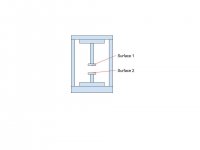StudentMech27
Plastic
- Joined
- Oct 12, 2017
Hey all,
A friend asked me a question and I couldn't think of an answer off the top of my head so while I think on it I'd like to get your guy's thoughts. He is using an Instron Tensile Testing machine and has created a fixture set up for his specific test. He would like to know how he can test is the two surfaces are parallel to one another. I attached a rough picture of what he is trying to get at (as best as he could explain it to me). Thanks for any insight that you could give on this subject!
Thank you!

A friend asked me a question and I couldn't think of an answer off the top of my head so while I think on it I'd like to get your guy's thoughts. He is using an Instron Tensile Testing machine and has created a fixture set up for his specific test. He would like to know how he can test is the two surfaces are parallel to one another. I attached a rough picture of what he is trying to get at (as best as he could explain it to me). Thanks for any insight that you could give on this subject!
Thank you!


